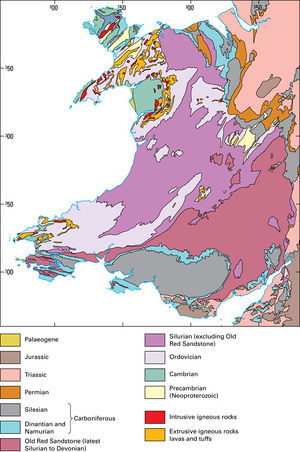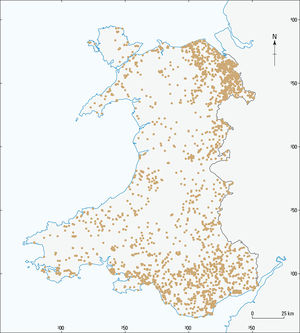Hydrogeology of Wales: Introduction - geology and groundwater
| This page is part of a category of pages that provides an updated review of the occurrence of groundwater throughout Wales. Author(s): N S Robins and J Davies, British Geological Survey Contributor(s): D A Jones, Natural Resources Wales and G Farr, British Geological Survey |

The geology of Wales is extraordinarily diverse; the geological descriptions in this report are based on those presented in the regional geochemistry atlas for Wales (BGS, 2000) although some terminology has since changed. The stratigraphical sequence in Wales extends from the Precambrian through to recent. The oldest rocks occur in north Wales and are mainly metamorphic and igneous Precambrian and Cambrian rocks (Figure P841814). Central Wales is dominated by Lower Palaeozoic age sediments (Ordovician and Silurian) trending south-west to north-east. The Precambrian and early Lower Palaeozoic rocks are overlain by Devonian sandstones, mudstones and conglomerates in east Wales and the Welsh Borderland. Carboniferous strata are present in south Wales and parts of the north, Triassic strata occur in the Vale of Clwyd and Jurassic deposits occur in the Vale of Glamorgan. Till and associated glacial material are widespread on the lower-lying ground but tend to be absent in many upland areas. Alluvium and glacial outwash material occur in many valleys and there are several large groundwater dependent peat bogs. Soil cover is typically thin on the higher ground, particularly in parts of Snowdonia where outcrop is extensive.
Hydrogeological maps for northern and southern Wales (BGS, 1986; 1989) provide a valuable graphical summary of the occurrence and nature of groundwater in the Principality. Marginalia to these maps include cross-sections, hydrochemical information, selected hydrographs, rainfall distribution and a summary description of groundwater availability. However, such maps are not available for central Wales as the groundwater systems contained within the basement rocks in this area have not previously been considered in resource terms.
The Late Neoproterozoic, Cambrian, Ordovician and Silurian rocks have a low interstitial porosity and permeability, although many have a limited fracture permeability and porosity. Depth of weathering tends to be shallow especially on valley sides where glacial erosion has removed weathering products. Groundwater occurs within an otherwise shallow weakly permeable aquifer that is capable of maintaining rural domestic and limited agricultural and industrial demand.
The Upper Old Red Sandstone in south to mid Wales consists mainly of unconsolidated, well-cemented, flaggy sandstones with thin sandy marls. Most groundwater flow is limited to fractures, but marl bands limit vertical flow and promote hillside springs. The Devonian aquifer is regionally important in sustaining a large number of public and private water supplies, although groundwater yields and springs may decline during prolonged periods of dry weather and some may dry up completely. The Lower Old Red Sandstone is essentially mudstone and siltstone.
Carboniferous sediments, mainly limestones overlain by Coal Measures Facies, occur both in the south and north-east of Wales and in Anglesey. The limestones represent an important groundwater source and have a high fracture permeability resulting from a well-developed joint and fracture system, but with low matrix permeability. Karstic flow conditions occur throughout the limestones other than those in Anglesey. Significant yields are obtained from major spring resurgences that generally occur near the base of the sequence or along faults. Groundwater flow velocities can be rapid with movement taking place along a small number of large fractures. Recharge processes are supplemented by shallow holes or dolines that form point sources for recharge. Significant quantities of groundwater were formerly pumped from mainly fractured sandstones of the Middle Coal Measures and Pennant Sandstone Formation within the South Wales Coalfield both for mine dewatering and public water supply.
Triassic-age sandstones are found in north-east Wales in the Clwyd–Merseyside Basin and form a small aquifer that is exploited for public supply in the Vale of Clwyd. The strata comprise cross-bedded, well-cemented, fine- to medium-grained sandstones with thin lenses of mudstone. The sediments generally exhibit high fissure and intergranular permeability. Clay-grade superficial deposits cover the Triassic outcrop restricting recharge in some places and confining the underlying aquifer to generate artesian heads of up to 6 m above ground level.
Local Quaternary deposits (mainly glaciofluvial, alluvial and colluvial) throughout Wales are thin and variable in nature but have a high permeability and are useful in providing local domestic supplies especially in low-lying areas. They may be poorly protected and vulnerable to surface pollution.
Most of the aquifers in Wales are unconfined and have shallow flow systems. The groundwater is generally well oxygenated and weakly mineralised with calcium and bicarbonate forming the main ionic components. More strongly mineralised groundwater, depleted in oxygen, occurs in deeper aquifer systems. Groundwater from the Silurian and Ordovician strata is generally of good quality, varying from Ca-HCO3 to Ca-Na-Cl types in relation to local geology, residence time and drift type. Deeper water from the confined Coal Measures facies is typically of poor quality due to the solution of iron and sulphate resulting from many years of mining below the water table. The Triassic strata are typically moderately mineralised and of the Ca-HCO3 type.

Whereas the groundwater potential of much of Wales has traditionally been ignored (Bassett, 1969), the requirements of European Community Directives such as the Water Framework Directive have provided a new focus. Data are available on the Triassic and Devonian aquifers but remain scarce for much of the Carboniferous, other than the Carboniferous Limestone, and the fractured hard-rock aquifers which prevail in central and west Wales (Robins et al., 2005). The distribution of water boreholes based on British Geological Survey/Environment Agency records (Figure P859258) indicates a paucity of data outside north Wales and the Cheshire Basin and parts of south Wales.
Although Wales has never been dependent on its groundwater resources, there have been some significant innovative groundwater schemes. These include the Clwyd Augmentation/Abstraction Scheme (Lambert, 1981; ESI, 2003), the Dee Regulation Scheme and hydrogeological investigations carried out during the development of the Cardiff Bay Barrage (Heathcote et al., 2003).